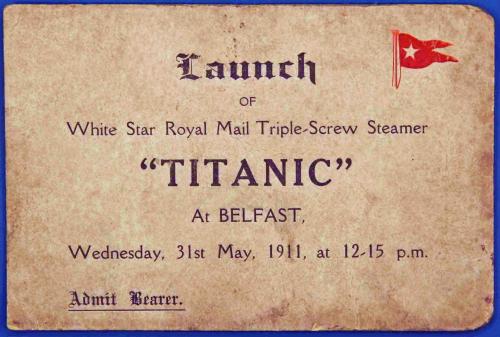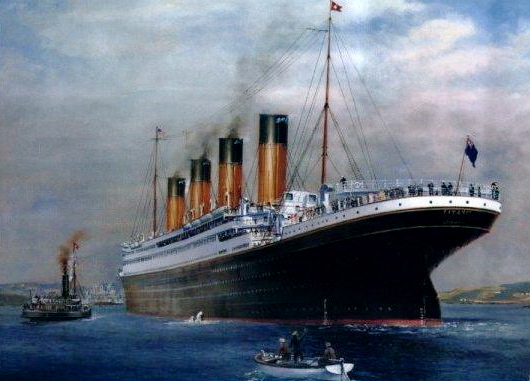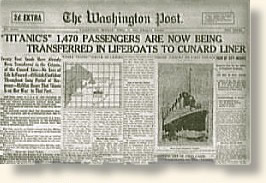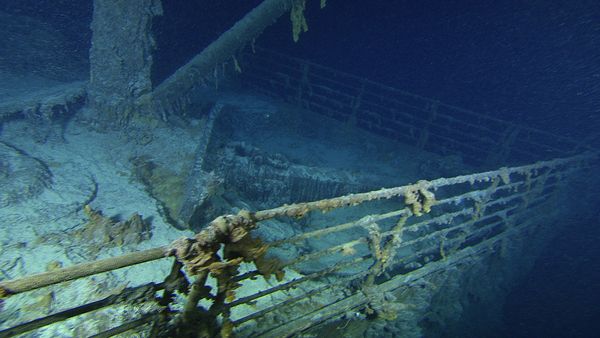A very famous, albeit sad, anniversary of a great ship.

From launch to maiden voyage, 100 years ago today.

And just four, short days after RMS Titanic left Southampton for her maiden voyage; on April 14th, at 11.40 pm ….

“The Sinking of the Titanic, 1912,” EyeWitness to History www.eyewitnesstohistory.com (2000).
On April 10, 1912, the Titanic, largest ship afloat, left Southampton, England on her maiden voyage to New York City. The White Star Line had spared no expense in assuring her luxury. A legend even before she sailed, her passengers were a mixture of the world’s wealthiest basking in the elegance of first class accommodations and immigrants packed into steerage.
She was touted as the safest ship ever built, so safe that she carried only 20 lifeboats – enough to provide accommodation for only half her 2,200 passengers and crew. This discrepancy rested on the belief that since the ship’s construction made her “unsinkable,” her lifeboats were necessary only to rescue survivors of other sinking ships. Additionally, lifeboats took up valuable deck space.
Four days into her journey, at 11:40 P.M. on the night of April 14, she struck an iceberg. Her fireman compared the sound of the impact to “the tearing of calico, nothing more.” However, the collision was fatal and the icy water soon poured through the ship.
It became obvious that many would not find safety in a lifeboat. Each passenger was issued a life jacket but life expectancy would be short when exposed to water four degrees below freezing. As the forward portion of the ship sank deeper, passengers scrambled to the stern. John Thayer witnessed the sinking from a lifeboat. “We could see groups of the almost fifteen hundred people still aboard, clinging in clusters or bunches, like swarming bees; only to fall in masses, pairs or singly, as the great after part of the ship, two hundred and fifty feet of it, rose into the sky, till it reached a sixty-five or seventy degree angle.” The great ship slowly slid beneath the waters two hours and forty minutes after the collision
The next morning, the liner Carpathia rescued 705 survivors. One thousand five hundred twenty-two passengers and crew were lost. Subsequent inquiries attributed the high loss of life to an insufficient number of lifeboats and inadequate training in their use.
Read more of this fascinating account, especially the story of Elizabeth Shutes who, aged 40, was governess to nineteen-year-old Margaret Graham who was traveling with her parents. As Shutes and her charge sit in their First Class cabin they feel a shudder travel through the ship. At first comforted by her belief in the safety of the ship, Elizabeth’s composure is soon shattered by the realization of the imminent tragedy.
Also grateful to my cousin, Rose F., who sent me a link to a story in the British newspaper The Telegraph that came out in September, 2010. I don’t have permission to reproduce that story but hope that it being 18 months since it was published by the Telegraph makes my act forgiveable!
Titanic sunk by steering blunder, new book claims
It was always thought the Titanic sank because its crew were sailing too fast and failed to see the iceberg before it was too late.
10:55PM BST 21 Sep 2010
But now it has been revealed they spotted it well in advance but still steamed straight into it because of a basic steering blunder.
According to a new book, the ship had plenty of time to miss the iceberg but the helmsman panicked and turned the wrong way.
By the time the catastrophic error was corrected it was too late and the side of the ship was fatally holed by the iceberg.
Even then the passengers and crew could have been saved if it had stayed put instead of steaming off again and causing water to pour into the broken hull.The revelation, which comes out almost 100 years after the disaster, was kept secret until now by the family of the most senior officer to survive the disaster.
Second Officer Charles Lightoller covered up the error in two inquiries on both sides of the Atlantic because he was worried it would bankrupt the liner’s owners and put his colleagues out of job.
Since his death – by then a war hero from the Dunkirk evacuation – it has remained hidden for fear it would ruin his reputation.
But now his granddaughter the writer Lady (Louise) Patten has revealed it in her new novel. “It just makes it seem all the more tragic,” she said. “They could easily have avoided the iceberg if it wasn’t for the blunder.”
The error on the ship’s maiden voyage between Southampton and New York in 1912 happened because at the time seagoing was undergoing enormous upheaval because of the conversion from sail to steam ships.
The change meant there were two different steering systems and different commands attached to them.
Some of the crew on the Titanic were used to the archaic Tiller Orders associated with sailing ships and some to the more modern Rudder Orders.
Crucially, the two steering systems were the complete opposite of one another.
So a command to turn “hard a starboard” meant turn the wheel right under the Tiller system and left under the Rudder.
When First Officer William Murdoch spotted the iceberg two miles away, his “hard a-starboard” order was misinterpreted by the Quartermaster Robert Hitchins.He turned the ship right instead of left and, even though he was almost immediately told to correct it, it was too late and the side of the starboard bow was ripped out by the iceberg.
“The steersman panicked and the real reason why Titanic hit the iceberg, which has never come to light before, is because he turned the wheel the wrong way,” said Lady Patten who is the wife of former Tory Education minister, Lord (John) Patten.
Whilst her grandfather Lightoller was not on watch at the time of the collision, her book Good as Gold reveals that a dramatic final meeting of the four senior officers took place in the First Officer’s cabin shortly before Titanic went down.
There, Lightoller heard not only about the fatal mistake, but also what happened next, up on the bridge.
While Hitchins had made a straightforward error, what followed was a deliberate decision.
Bruce Ismay, chairman of Titanic’s owner, the White Star Line, persuaded the Captain to continue sailing. For ten minutes, Titanic went “Slow Ahead” through the sea.
This added enormously to the pressure of water flooding through the damaged hull, forcing it up and over the watertight bulkheads, sinking Titanic many hours earlier than she otherwise would have done.
“Ismay insisted on keeping going, no doubt fearful of losing his investment and damaging his company’s reputation,” said Lady Patten. “The nearest ship was four hours away. Had she remained at ‘Stop’, it’s probable that Titanic would have floated until help arrived.”
The truth of what happened on that historic night was deliberately buried.
Lightoller, the only survivor who knew precisely what had happened, and who would later go on to be a twice-decorated war hero, decided to hide what he knew from the world, including two official inquiries into the sinking.
By his code of honour, he felt it was his duty to protect his employer – White Star Line – and its employees.
Lady Patten said: “The inquiry had to be a whitewash. The only person he told the full story to was his beloved wife Sylvia, my grandmother. As a teenager, I was enthralled by the Titanic. Granny revealed to me exactly what had happened on that night and we would discuss it endlessly.
She died when I was sixteen and, though she never told me to keep the knowledge to myself, I didn’t tell anyone. My mother insisted that everything remained strictly inside the family: a hero’s reputation was at stake.
Nearly forty years later, with Granny and my mother long dead, I was plotting my second novel and it struck me that I was the last person alive to know what really happened on the night Titanic sank.
My grandfather’s extraordinary experiences felt like perfect material for Good As Gold.
© Copyright of Telegraph Media Group Limited 2010
Anyone who reads this and is as fascinated as I was should read the comments as there is much discussion about the nature of the steering error.

w0w…i’m speechless
LikeLike
Very interesting. These new revelations, if true, are fascinating.
Perhaps even more interesting, there have been many much larger sea disasters since. Whereas it is useful to study one in ever greater detail, the others deserve mention too, because they are wisdom juicy in their own special ways!
There is actually wisdom to be picked up in how indifferent we are to non Anglo-Saxon (and generally well to do) lives lost at sea…
PA
LikeLike
That’s a sobering reflection and a very quick web search confirmed that, see http://en.wikipedia.org/wiki/List_of_maritime_disasters (assuming this is an accurate list).
LikeLike
They missed the largest of them all. But who cares about 6,000 German women and children? It seems a ferry or two are also missing…
LikeLike
Thanks Paul, you have pre-empted my own “tribute” to the Titanic by a few days but, what a revelation Lady Patten’s secret is… How come more has not been made of this? There would seem to be no reason to doubt what she says and, if it is true, why have none of the many programmes on the TV marking the centenary of the disaster mentioned this? Is it that we are all too comfortable with the myth that has grown up around the doomed ship? I hope not because, as film director and underwater explorer James Cameron points out, there is much we could actually learn from it…
LikeLike
“The error on the ship’s maiden voyage between Southampton and New York in 1912 happened because at the time seagoing was undergoing enormous upheaval because of the conversion from sail to steam ships. The change meant there were two different steering systems and different commands attached to them.”
We seem incapable of learning from the lessons of history. Almost a century later, a probe to Mars was lost for a similar reason.
PS I have my own take on what happened to the Titanic 😉
LikeLike
I guarantee that even in a thousand years, you won’t guess what Pedantry wrote about with regard to his own explanation of how the Titanic was lost. Do take a peek!
LikeLike
Excellent Post Paul… the BBC here has been paying their own tributes with much information as to those who were upon the Titanic. Much coverage.. But like your commenter’s have said, More huge disasters have taken place since then, with tragic loss of life…. A fitting tribute to all who have lost their lives at Sea..
LikeLike
I share your puzzlement, especially as the story was carried by a newspaper of the calibre of the Daily Telegraph many months ago. P.
LikeLike
Sometimes Paul I often think the Media over-kill certain topics in order to distract us from other ones. 😉 which are in the lime-light right now.. Method always to Madness.. 🙂
LikeLike
What a suspicious mind you have! 😉
LikeLike
Yes Tribute to all those who lost their lives during this disaster but looks like the world and the media are being hypocrites….there has never been any remembrance of slaves that were dumped by the western world in deep seas during the slave trade……its really sad how the world thinks
LikeLike